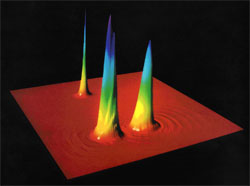Atomic, Molecular & Optical Science (AMOS) Instrument
PURPOSE: This instrument will enable the study of the interaction between the extremely intense LCLS x-ray pulses and the basic constituents of matter: atoms and molecules.
A very-intense, ultrashort x-ray pulse will interact with matter in ways that a less-intense beam from a conventional synchrotron source will not. Such strong-field effects are important to understand and characterize as they may alter the basic properties of the materials being studied, or even affect the basic physics of the methods being used for studying them. In addition, the strong-field effects will open new paths for studying the basic physics of atoms and simple molecules, and their interactions with each other, leading possibly to new types of lasers or other exotic materials.
Optical laser experiments and theoretical studies have led to a very detailed understanding of how atoms behave when their constituent electrons are stripped off. However, optical lasers interact most strongly with an atomís outermost electrons. X-rays interact most strongly with an atomís core electrons. Therefore, whereas strong optical lasers strip an atom from the outside in, the LCLS will be able to strip them from the inside out. The differences in the resulting atomic fragmentation process may be profound. In addition, due to the different energy scales, the cross sections for damage to atoms should be very different for LCLS x-rays than for optical lasers.
Problems to be addressed in this virtually unexplored area of science include:
- Elementary intense field atomic & molecular inner-shell photofragmentation
- X-ray nonlinear processes
- X-ray driven cluster dynamics
- Complex electron motion in materials
- Static & time-resolved x-ray imaging of molecular structure

Calculations of the normal hydrogen ground state electron density distribution (background) and the strikingly-distorted, bi-local distribution (foreground) for the new ground state created by interaction with a short, super-intense, x-ray FEL. This new state of matter cannot be created by any existing source of light. [from J. H. Eberly and K. C. Kulander, Science 262, 1229 (1993)].
INSTRUMENT CONCEPT: The experiment concept is simple: a controlled, intense pulse of LCLS soft x-rays hits an atom or molecule or cluster, and the resulting products are collected and analyzed. Soft x-rays are preferred, since they interact most strongly with simple atoms. The subtlety of the effects being studied presents some complications, however. The bright, soft-x-ray light from LCLS will provide an enormous number of photons that can simultaneously interact with a sample of atoms. A cascade of atom fragments (electrons, ions and photons) results. The signature of the resulting fragmentation can be an incoherent sum of single-photon absorption events, or a coherent process that scrambles the signatures of the single-photon events. An instrument capable of measuring the energy and direction of the fragments alone is not sufficient to unravel this complexity. The instrument must also be capable of determining the correlations among the various fragment particles (the interaction among the fragments) using the technique of coincidence spectroscopy. This scenario applies even for the simplest isolated atom interacting with the intense x-ray beam.
The instrument will have target density control and vacuum capability such that only one atom or molecule (on average) will interact with the LCLS x-ray beam. This will not only simplify the fragment analysis but also enable a coincidence analysis among the various fragments. The x-ray pulse will be conditioned by a monochromator and focusing elements, and its various characteristics such as intensity will be measured with each shot. Measurements of the atom fragmentsí energy and spatial distribution will be performed with high-resolution spectrometers. Consequently, the AMOS instrument will be equipped with an array of detectors (electron, ion, photon) positioned around the circumference of a sphere ensuring optimum collection efficiency and excellent resolution. The signal from the individual detectors will be processed for every shot of the intense x-rays and a time history of events maintained for post-collection analysis.
Uniqueness: This instrument will be uniquely capable of studying in detail the interaction between extremely-intense x-ray pulses and simple forms of matter: atoms and simple molecules. By minimizing the complexity of the samples, and using a number of analytic devices to study the atom fragments, it will be possible to develop an understanding of the strong-field effects that can occur when LCLS x-ray pulses strike any form of matter.
